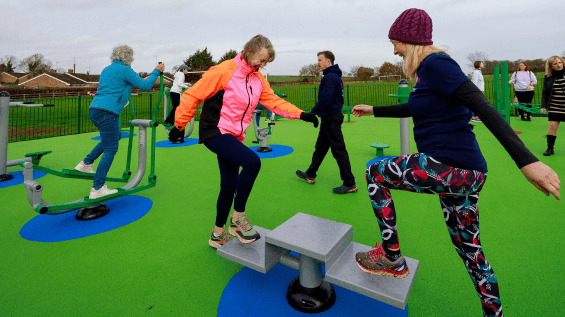
Oct

Outdoor Gym Equipment for Parks: A guide for Parish Councils
Parish and local councils have a direct influence on the health of their communities. Well-designed outdoor spaces encourage residents to move more, spend time together, and enjoy the benefits of being active in daily life. Among the most practical options available, installing outdoor gym equipment for parks gives people of all ages a free and accessible way to improve fitness while making parks more vibrant and inclusive.
Outdoor gyms are growing in popularity because they provide free, accessible fitness opportunities for all ages. They are cost-effective compared to indoor facilities and fit well within wider strategies to increase physical activity.
According to Sport England’s Active Lives Adult Survey, 63.7 percent of adults met the recommended 150 minutes of activity per week between November 2023 and November 2024. While encouraging, this means more than a third of adults remain inactive or insufficiently active, highlighting the need for solutions that remove barriers to participation (Sport England, Active Lives Survey 2023–24).
This guide sets out the benefits of outdoor gym equipment for parks, what councils need to consider when planning, and how to secure funding to make these projects a reality.
What is Outdoor Gym Equipment for Parks?
Outdoor gym equipment for parks refers to robust, weather-resistant fitness apparatus designed for permanent installation in public spaces. Unlike indoor gyms, outdoor versions are unsupervised and available to all residents free of charge.
Typical features include:
Cardio equipment such as air walkers, cross trainers, rowers, and hand cycles.
Strength stations include leg presses, chest presses, pull-up bars, and dip stations.
Calisthenics frames for scalable bodyweight training.
Mobility and stretching equipment to support older residents and beginners.
A well-designed outdoor gym caters to a broad range of abilities. Many suppliers offer accessible options such as hand cycles for wheelchair users, lower transfer stations, and equipment with supportive seating. This inclusive approach ensures that everyone has the opportunity to take part in physical activity, regardless of age or ability.
Benefits of Installing Outdoor Gym Equipment in Parks
Installing outdoor gym equipment for parks provides measurable benefits for residents and councils.
Accessible, Free Fitness for All Residents
Parks are open year-round and free to access. Outdoor gyms remove cost barriers and provide opportunities for residents who might not feel comfortable joining an indoor facility. They also allow people to exercise at a time that suits their lifestyle, whether early morning, lunchtime, or evening.
Supporting Public Health Targets
Outdoor gyms contribute directly to public health priorities such as reducing obesity, tackling inactivity, and improving mental health. NHS guidelines recommend adults achieve at least 150 minutes of moderate activity per week, yet many fall short of this target (NHS, Physical Activity Guidelines for Adults). Outdoor gyms provide convenient ways to integrate exercise into daily life and can help reduce reliance on NHS services over time.
Encouraging Social Interaction
Unlike solitary exercise at home, outdoor gyms bring people together. Residents often use equipment alongside neighbours, friends, or family members, which fosters social connections. When gyms are located near playgrounds, parents and carers can be active while children play, making facilities truly multi-generational.
Boosting Community Engagement
Visible investment in public facilities signals that councils are committed to community wellbeing. This strengthens trust and encourages residents to take pride in local spaces.
Planning Considerations for Councils
Successful projects depend on careful planning from the outset.
Location Within the Park
Choose a site that is visible, accessible, and well used. Proximity to paths, play areas, or community hubs helps increase usage. Avoid hidden corners that may discourage residents or raise safety concerns. Step-free access is essential for inclusive use.
Linking Gyms with Playgrounds or Walking Routes
Outdoor gyms are most effective when integrated into wider park activity. Placing gyms next to playgrounds enables parents to be active while children play. Linking equipment with walking or running routes creates natural circuit training opportunities.
Equipment Choice
A balanced gym offers cardio, strength, and flexibility stations. Consider local demographics when planning. For example, areas with larger older populations may
Prioritise low-impact equipment, while younger communities may benefit from calisthenics stations and strength apparatus.
Surfacing and Safety Requirements
The surfacing under and around outdoor gym equipment plays an essential role in safety, accessibility, and durability.
Surfacing Options
Wet pour rubber: Provides impact absorption and allows creative use of colours and patterns.
Bonded rubber mulch: Offers a natural look and is suitable for sloped areas.
Resin-bound gravel: Firm and accessible, ideal for paths and surrounding zones.
Durability and Cost Efficiency
High-quality surfacing reduces maintenance costs and ensures facilities remain open. Surfaces should be slip-resistant, well-drained, and suitable for wheelchair access.
Compliance and Accessibility
Installations should meet BS EN 16630, the European standard for outdoor fitness equipment, alongside appropriate surfacing standards. These ensure equipment and surfaces are safe for public use and compliant with legal obligations.
Maintenance and Longevity
Councils should plan for the entire lifecycle of outdoor gym equipment for parks.
Lifecycle Costs
While installation is the initial investment, ongoing maintenance is equally important. Budgeting for inspections, cleaning, and repairs ensures long-term value.
Supplier Aftercare
Choose suppliers who provide aftercare services, including replacement parts and spares. This reduces downtime and extends equipment life.
Regular Inspections
Annual independent inspections alongside routine visual checks are recommended for safety compliance. Recording inspections and maintenance also supports council accountability.
Funding Options for Parish and Local Councils
Financing outdoor gym projects often requires a combination of funding sources.
Community Grants
National and regional grants, such as Sport England’s Movement Fund, support projects that encourage more people to be active. These funds are often aimed at communities facing barriers to participation.
Section 106 Agreements
Councils can use Section 106 planning obligations to secure contributions from housing developers towards local infrastructure. Outdoor gyms that serve new housing developments are often eligible for this funding.
Local Fundraising and Partnerships
Partnerships with local charities, businesses, or resident groups can provide additional funding. Community ownership through fundraising often leads to higher engagement once the gym is installed.
Cost Effectiveness Compared to Indoor Facilities
Outdoor gyms require no staffing or membership management. This makes them more cost-effective than indoor gyms while offering similar benefits in terms of health outcomes and activity levels.
FAQs
What equipment is included in an outdoor gym for parks?
A typical installation includes cardio stations, strength equipment, and stretching frames. Many also feature callisthenics rigs and accessible stations for wheelchair users.
How much does outdoor gym equipment cost for councils?
Costs vary depending on the number of stations, ground conditions, and surfacing choices. Councils should budget for installation and long-term maintenance.
What are the safety requirements for outdoor gym equipment?
Equipment must comply with BS EN 16630. Councils should also ensure surfacing meets safety standards and that routine inspections are carried out.
How long does outdoor gym equipment last?
With proper maintenance, outdoor gym equipment typically lasts 10 to 15 years or more. Choosing suppliers with robust warranties and aftercare services extends this lifespan.
Outdoor gym equipment for parks offers parish and local councils a practical, affordable, and inclusive way to promote healthier lifestyles. These gyms reduce barriers to activity, support public health goals, and create welcoming spaces that bring communities together.
If your council is considering an outdoor gym, Caloo can help. Our team specialises in designing and installing equipment that meets safety standards, aligns with community needs, and supports long-term use. Contact us today to explore tailored outdoor gym solutions for your park.
References
Sport England. Active Lives Adult Survey November 2023–24 Report. Sport England, April 2025.
“63.7 percent of adults met the recommended 150 minutes of activity per week.”
Available from Sport England website: https://www.sportengland.org
NHS. Physical activity guidelines for adults aged 19 to 64. NHS, 2023.
“Adults should aim for at least 150 minutes of moderate intensity activity each week, or 75 minutes of vigorous activity, alongside muscle strengthening activities on at least two days.”
Available from NHS website: https://www.nhs.uk/live-well/exercise/physical-activity-guidelines-for-adults-aged-19-to-64/
British Standards Institution (BSI). BS EN 16630:2015. Permanently installed outdoor fitness equipment. Safety requirements and test methods. London: BSI Standards Limited, 2015.
This standard sets out the safety requirements and test methods for permanently installed outdoor fitness equipment intended for use by people above 1.4 metres in height.
GOV.UK. Planning Obligations: Guidance. Department for Levelling Up, Housing and Communities, 2023.
Provides official guidance on the use of Section 106 planning obligations, including how contributions can be used for local infrastructure such as outdoor recreation facilities.
Available from GOV.UK: https://www.gov.uk/guidance/planning-obligations
Sport England. The Movement Fund. Sport England, 2024.
Funding programme supporting community projects that encourage people to be more active, with grants of up to £15,000 available.
Available from Sport England website: https://www.sportengland.org/funding-and-campaigns/our-funding/movement-fund

















